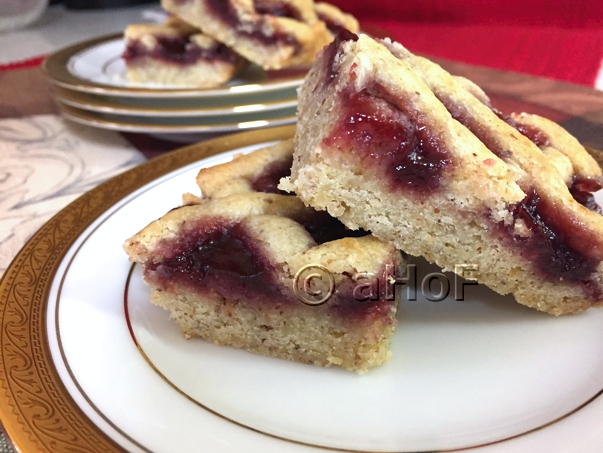 |
| Raspberry Linzer Squares |
 |
| Raspberry Linzer Squares just cut |
I would not mess with the crust part of the recipe, as it is just divine. Looking at the photos, it seems that the crust might be dry, but this is so not the case. It is tender and as it has ground nuts in it, nuts do help with moistness. The kind of nuts to use is entirely up to the individual. I used walnuts as they are my favorites, but pecans, hazelnuts, almonds or even macadamia would also work. The important thing is to have them very finely ground.
One thing the woman who gave me this recipe stated was that normally the lattice top is meant to be rolled out flat and cut into strips to set on top. She felt this was too tedious since the dough is delicate and easily breaks, so she suggested just rolling the dough into thinner-than-pencil sized strips and setting them on top. It works the same either way and makes life easier.
I am all about making life easier!
Another thing that can be done, but I did not, is to brush the top lattice with an egg wash (1 egg yolk beaten with 1 tablespoon of water) before baking. This would make the lattice shiny and more golden. I meant to try it, but I totally forgot in my rush to bake this dessert! So obviously they came out wonderfully well despite this lapse. The dessert is made in a 9 x 9-inch pan, and the final "bars" can be cut into 12 bar type pieces or 16 squares; your choice. And here is the recipe for these wonderful bar type cookies.
 |
| Raspberry Linzer Squares |
Raspberry Linzer Squares
Makes 12 or 16 squares1½ cups all-purpose flour +2 tablespoons
¾ cup sugar
½ teaspoon baking powder
¼ teaspoon salt
½ cup hazelnuts, ground (or almonds, walnuts, pecans or macadamia)
½ cup unsalted butter at room
temperature
1 tablespoon grated lemon zest
1 whole egg, beaten
¾ cup thick raspberry Jam
1 egg yolk
1 teaspoon water
Preheat oven to 350. Line a 9-inch square pan with parchment for easy removal and cutting later. Spray the parchment with cooking spray and set aside.
Into a large mixer bowl, measure the 1½ cups of flour. (Reserve the extra 2 tablespoons for later). Add sugar, baking powder, salt, nuts, and butter; mix until well combined. Add lemon zest and egg, stirring with a fork until dry ingredients are moistened. Reserve ½ cup of dough aside. Pat remaining dough evenly into the bottom of the pan. Spread the preserves over dough in pan. To the reserved half-cup of dough, stir in the remaining 2 tablespoons flour. Roll this dough to very thin pencil like strips and place 9 strips in a diagonal over the preserves, about ½" apart. Place the remaining 9 strips crosswise over the first strips, ½” apart, forming a lattice top.
In small bowl, stir the egg yolk and water; brush dough strips. Bake for 30 minutes or until top is golden brown. Cool completely on wire rack in pan. Cut into bars.
My passion is teaching people how to create a harmony of flavors with their cooking, and passing along my love and joy of food, both simple or exotic, plain or fancy. I continue my journey in ethnic and domestic cuisines, continuing my journey to explore diverse culinary experiences and hopefully to start you on a journey of your own. Join me also at A Harmony of Flavors on Facebook, and Pinterest.




